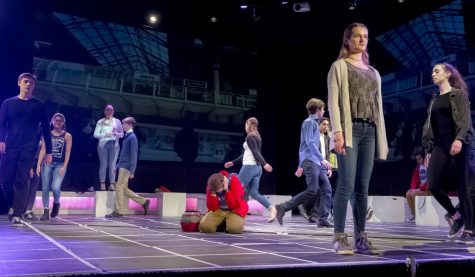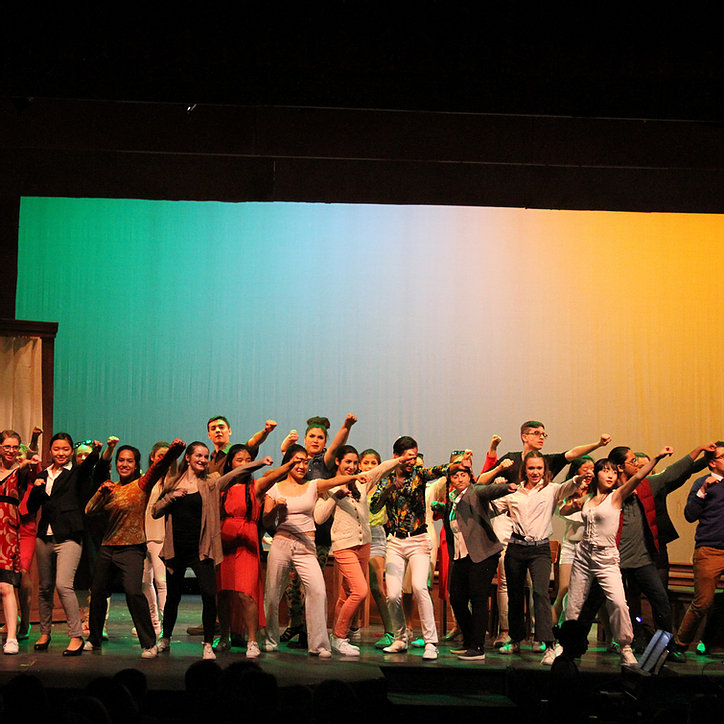A Different Look at Theatre: Stop Making Musicals the Necessity
February 12, 2021
Musical theatre is not all it’s cracked up to be. The dancing, singing, and knowing all the words to the rap about infamous rivals of American history conspicuously define what being a “theatre kid” is. Immensely loud, dramatic, bursting out in song and dance every chance they get anywhere and anytime, and maybe even coming off as exasperating (sometimes). That is what many people think of when they think of a theatre kid. But that is simply not the case, and more appreciation for straight plays should exist.
Musicals seem to be the epitome of all things theatre, but its alternate counterpart of the performing arts genre, straight plays, are rarely valued to the same extent by most people, actors and nonactors alike (but more frequently by the latter). Tell me, have you heard people refer to a show as a Broadway play more than you’ve heard it referred to as a Broadway musical? Or could you tell me with certainty that more high schools put on a play every year rather than a musical? I don’t think you could. Let’s examine why. What I hear from many people is that musicals are more entertaining to watch than plays. And, of course, if something is more entertaining, it will be more preferred. But what exactly makes a musical more enjoyable to watch? The singing and dancing? Sure, musical numbers can carry catchy tunes that reiterate what is going on in the story. Or maybe just listening to music on top of the characters speaking to each other enhances the show. However, it must be said that plays can just as well make use of music to intensify the performance. There can be musicians either on stage or offstage who play instruments live in the background or as a side during the play. Take the Broadway production of King Lear (2019), for instance. I remember being in the audience and seeing a string quartet on stage who accompanied the actors in bringing the play to life. The musicians were dressed in formal evening wear matching the attire of the rest of the cast of the play, except that they wore all black like they were heralds of death who followed all the characters in the course to their demise. The beautiful string sound, composed by Philip Glass, acted the way a soundtrack to a movie would and strengthened the drama and tension of the tragedy.

Another instance of a play that is wholly interactive as a musical is Tenafly High School’s 2019 production of The Curious Incident of the Dog in the Night-Time. There wasn’t a live group of musicians, but loud electronic music and flashing lights were heavily used in this one. The play follows the main character, Christopher, who is on the autism spectrum and ventures to London for the first time. When Christopher plays Tetris, the nostalgic Tetris song could be heard, and to mimic the chaos of busy crowds in the metro, the blasting and exaggerated music worked well as the actors strutted all over the stage. No one could possibly fall asleep during this play. By eliminating the need to make the actors sing and dance in musical numbers, more opportunities to express creativity can be opened up and, most often, they can be unpredictable.
From the beginning of early history of theatre all over the world, from the Greeks to the Chinese, music and dance did accompany the actors’ performances. Although it can be said that this was the birth of musical theatre, the purpose of putting up a performance through acting on a stage was to communicate messages and share stories to all kinds of audiences, the rich or the illiterate poor. On top of music, straight plays reign supreme in terms of theatrical schemes. Yes, it’s impressive when the musical performers sing in tune and the music comes together. When there’s a dance number and the ensemble moves its bodies in all different ways, it is fun to watch once in a while. But there are only so many times you can watch musical numbers and not get sick of them. Besides, not everything can be sing-y lovey dovey. In real life, we don’t burst out into song when we encounter a problem. Or sing all our thoughts out loud. What we see in plays is authentic and, therefore, there is more esteem to be placed for the acting in plays. The actors replicate human emotion and try to be as real as they can. It takes more effort to captivate an audience through acting alone than singing and dancing, so when a play is done right and the audience (bonus points if they aren’t avid theatre goers like high schoolers who came to support their friends in the cast) gives a standing ovation, we should talk about its successes more.
With this in mind, I hope that putting on only straight plays as often as musical plays starts to become normalized. Not every theatre kid is a social butterfly who can sing and dance. In fact, many of the talented actors you see are really deep introverts who can break out of their shell through acting. Likewise, not everyone who can sing and dance can act. By prioritizing musicals for theatre, straight play actors feel put aside and discouraged as their only chance at participating in their public school’s theatre program is the one musical that is put up every year. If there even is one, that is. There is so much a straight play can offer than a musical would, if not more. So the next time you see a theatrical production opening, I hope you give straight plays a chance.

















































































































































